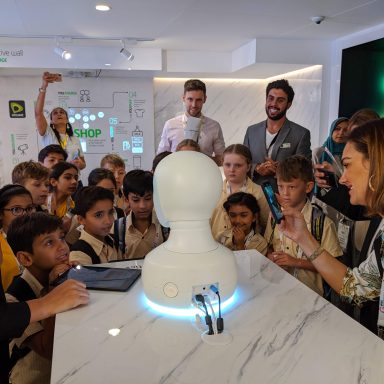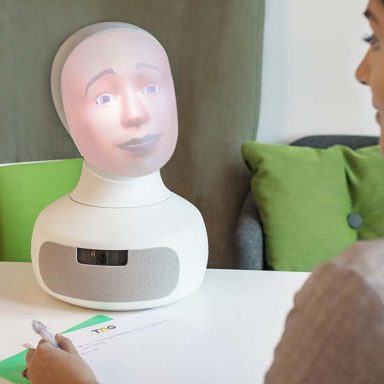As research continues and the technology becomes more advanced, social robots are slowly being adopted in more and more areas and are getting to help people in all kinds of new and innovative ways. Although there is much yet to be done and achieved, interacting with robots in our daily lives is no longer a dream. From healthcare and education to business, social robots are showing that they are here to support humanity and not to replace it. These are some of the ways in which social robots are helping people and making the world a more inclusive and equal place:
How Social Robots are helping in Healthcare
During the covid pandemic, the healthcare industry underwent a transformation with the exponential growth of telehealth. Patients around the world love the convenience and speed of digital healthcare tools, and virtual appointments certainly made it safer for doctors to talk to patients during the pandemic. However, in-person healthcare will always be necessary and this is where social robots can be of great help to both patients and healthcare providers.
With the ability to listen and respond in real time like a human would, social robots are the only digital tool that can provide the attentive, efficient and empathetic service patients are looking for in physical appointments. Social robots are perfectly positioned to take some of the pressure off healthcare providers by registering patient details and performing basic screening tasks. This reduces the amount of time medical staff have to spend on administration and allows them to spend more time with patients, thereby increasing the quality of care.
Social robots also have another skill that is very important in the healthcare sector. Namely, they speak many languages and can be programmed to speak many more. Currently, there is a major shortage of certified medical interpreters at hospitals, which means that immigrants and Indigenous people often receive inadequate care because they cannot be understood by medical staff. With social robots at hospitals and clinics, all patients, no matter where they are from or what languages they speak, can be understood and can receive appropriate care.
The potential of social robots within healthcare is not limited to the examples above. It is easy to imagine many other ways social robots can support patients and medical staff. Furhat could help with speech therapy for patients overcoming brain injury, for instance, or could support medical staff with patient after-care education to ensure patients’ post-treatment journeys are as smooth as possible. Within healthcare, social robots really can have a big positive impact and much of the potential remains unexplored.
How Social Robots are helping in Education
Aside from healthcare, social robots have also had a very positive impact in education, particularly in special education. Social robots have been shown to be very helpful learning tools for children with learning disabilities and autism spectrum disorders. Research shows that children with special needs feel more comfortable and less overwhelmed interacting with robots than they do with other people. In a pilot program conducted at the special education department of the St. Vrain Valley Schools in Colorado, for example, social robots were able to help non-verbal children to communicate for the first time. This makes us wonder, what else is possible if we continue to explore how this technology can help children with special needs?
Although social robots are very helpful for children with special needs, they can be very helpful for teachers as well. Teachers suffer from the same chronic overwhelm and burnout issue as medical staff. With a social robot in every classroom, teachers would have the support that they need to manage large classes. Particularly in low-income and rural areas experiencing teacher shortages, social robots would ensure that every student gets the individual attention they need without teachers having to spread themselves too thin. This would ensure that all students, no matter where they live, can get the same quality of education and access to the opportunities that come with it. Social robots could be the answer to educational inequality!
Speaking of education inequality, a recent UNHCR report shows that refugee education is in crisis. There is a dire need not only for more teachers, but also for quality digital teaching tools that can be adapted to address extremely varied student needs. This is where social robots come in. They can ensure refugees of all ages have access to a quality, personalized education in the language of their choice. Furthermore, social robots can be programmed to help teachers provide emotional support to trauma survivors, as well as train teachers to provide trauma support to those who need it.
How Social Robots are helping in Business
Another area where social robots are contributing to greater equality is business. Despite laws prohibiting this kind of discrimination, recruitment discrimination remains a real issue. Whether it is implicit or explicit bias, women, immigrants, people of color and of certain religions are still discriminated against in the application process. Social robots can be programmed to avoid this kind of descrimination by judging applicants based on experience and merit only. This is what the HR-startup Tengai did.
A social robot is also perfectly positioned to listen to anonymous complaints that employees may feel uncomfortable sharing with another person, thereby creating a safe channel for people to voice their concerns and experiences. These could then be passed on to HR anonymously to create cultures of greater accountability where abuse can be reported without fear of retribution.
Social robots’ potential for good is not limited to healthcare, education and business. The advancements in the technology mean that social robots can perform any task requiring social interaction and communication, especially if that communication follows a certain structure with predetermined steps, like most professional communication does. This means that social robots can in theory perform any professional communication role. This does not mean robots will replace humans. It means that as the technology advances, social robots will be able to comfort, entertain and support humans in better and more complete ways.



